Contents
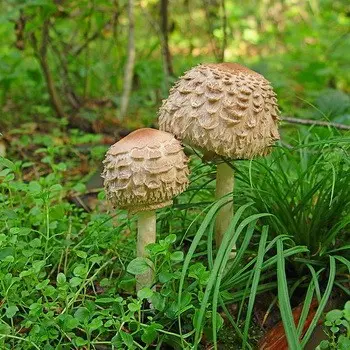 Umbrella mushrooms belong to the Champignon family and owe their name to the original appearance. Indeed, these edible mushrooms resemble umbrellas opened during the rain. These gifts of the forest have a delicious taste, which is why they are extremely appreciated by lovers of “quiet hunting”.
Umbrella mushrooms belong to the Champignon family and owe their name to the original appearance. Indeed, these edible mushrooms resemble umbrellas opened during the rain. These gifts of the forest have a delicious taste, which is why they are extremely appreciated by lovers of “quiet hunting”.
On this page, you can learn what umbrella mushrooms look like, where they grow, and how to distinguish umbrella mushrooms from other mushrooms. You can also get acquainted with the photo and description of umbrella mushrooms of various types (white, variegated and blushing).
What does a white umbrella mushroom look like, photo of a mushroom
Category: edible.
White parasol mushroom cap (Macrolepiota excoriata) (diameter 7-13 cm): usually grey-white, fleshy, with loose scales, may be cream or light brown. In young mushrooms, it has the shape of an egg, with time it becomes almost flat, with a distinct brown tubercle in the center.
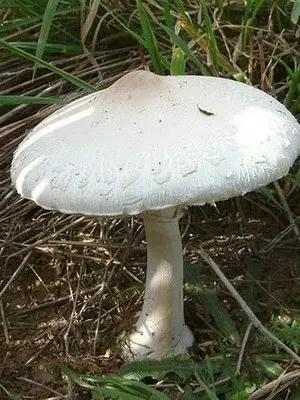
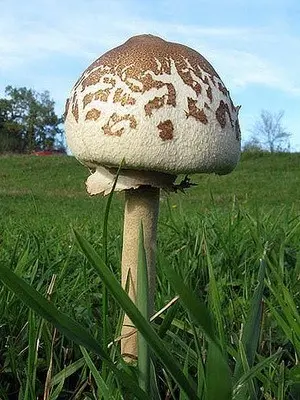
Pay attention to the photo of the porcini umbrella mushroom: the edges of his cap are covered with whitish fibers.
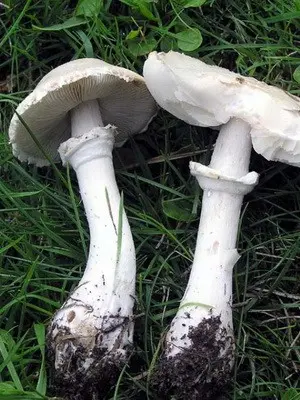
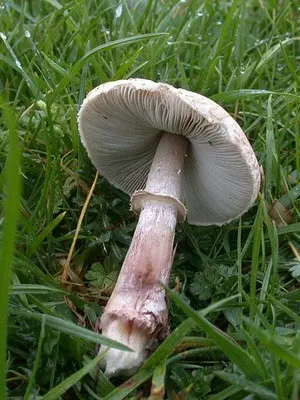
Leg (height 5-14 cm): hollow, has the shape of a cylinder. Usually slightly curved, white, darker below the ring. It turns visibly brown on touch.

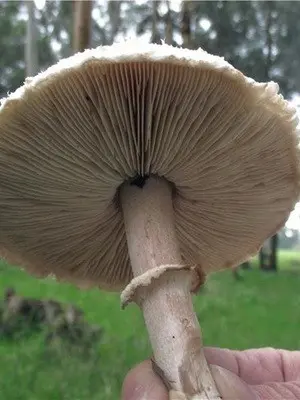
Records: white, very frequent and loose. In an old fungus, they become brown or with a brown tint.
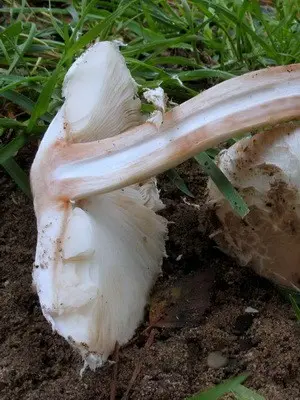
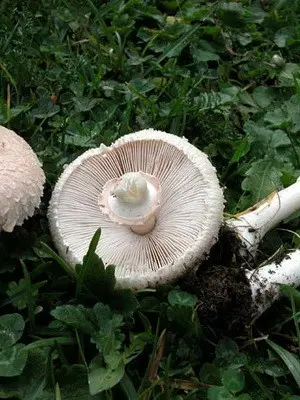
[ »»]
Pulp: white, with a pleasant intolerant smell. When interacting with air, the color on the cut does not change.
The parasol mushroom looks like a variegated species (Macrolepiota procera), but it is much larger. Also, the white variety resembles the mastoid umbrella (Macrolepiota mastoidea), Konrad’s umbrella mushroom (Macrolepiota konradii), as well as the inedible poisonous lepiota (Lepiota helveola). The Conrad species has a skin that does not completely cover the hat, the mastoid umbrella has a pointed hat, and the poisonous lepiot is not only much smaller, but also with flesh turning pink at the site of the break or cut.
When growing: from mid-June to early October in almost all countries of the Eurasian continent, as well as in North America, North Africa and Australia.
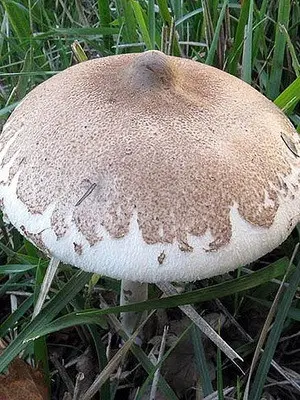
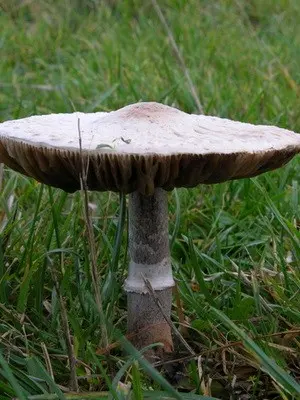
Where can I find: on relatively free areas of all types of forests – clearings, edges, pastures and meadows.
Eating: usually combined with fish or meat dishes. In adult mushrooms, you need to take only caps, the legs are most often hollow or fibrous. Very tasty mushroom, especially popular in traditional Chinese cuisine.
Use in traditional medicine (data are not confirmed and have not been clinically tested!): as a remedy for rheumatism.
Other names: parasol mushroom field.
[ »wp-content/plugins/include-me/ya1-h2.php»]
Edible umbrella mushroom blushing and his photo
Category: edible.
Red umbrella mushroom cap (Chlorophyllum rhacodes) (diameter 7-22 cm): beige, gray or light brown, with fibrous scales. In young mushrooms, it has the shape of a small chicken egg, which then slowly expands to a bell-shaped, and then becomes almost flat, as a rule, with tucked edges.
Leg (height 6-26 cm): very smooth, light brown or white, darkens with age.
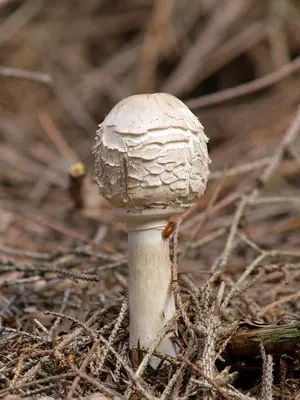

In the photo of the umbrella mushroom of this variety, it is clearly visible that the hollow, cylindrical leg tapers from the bottom up. Easily separated from the hat.
Records: usually white or cream. When pressed, they acquire an orange, pink or reddish hue.
Pulp: fibrous and brittle, white.
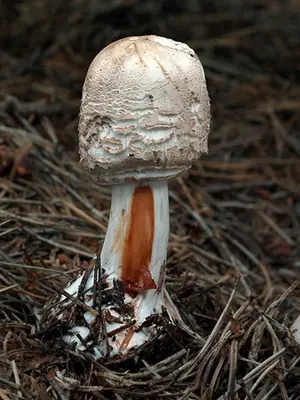
If you look closely at the photo of the blushing umbrella mushroom, then you can see red-brown stains on its cut. This is especially noticeable in the pulp of the leg. It has a pleasant taste and aroma.
[ »wp-content/plugins/include-me/goog-left.php»]
Doubles: umbrella mushrooms maiden (Leucoagaricus nympharum), graceful (Macrolepiota gracilenta) and variegated (Macrolepiota procera). The hat of the girl’s umbrella is lighter, and the color of its pulp practically does not change at the site of a break or cut. The graceful umbrella mushroom is smaller, the flesh also does not change color. The variegated umbel is larger than the blushing umbel and does not change the color of the flesh when exposed to air. Also, the blushing umbrella mushroom resembles the poisonous Chlorophyllum brunneum and lead-slag chlorophyllum (Chlorophyllum molybdites). But the first chlorophyllum can be distinguished from the reddening umbrella mushroom by the more brown color of the cap and stem, also by the large scales on the cap, and the lead slag grows only in North America.
When growing: from mid-June to early November in European and Asian countries, as well as in North America and North Africa.
Where can I find: prefers fertile and humus-rich soils of deciduous forests. It occurs in meadows, forest clearings or in city parks and squares.
Eating: in almost any form, only it is necessary to clean the mushroom from hard scales.
Application in traditional medicine: does not apply.
Important! According to scientists, the blushing umbrella mushroom can cause severe allergic reactions, so allergy sufferers should be careful when using it.
Other names: shaggy umbrella mushroom.
Motley umbrella mushroom: photo and description
Category: edible.
Hat of a motley parasol mushroom (Macrolepiota procera) (diameter 15-38 cm): fibrous, gray or beige, with dark brown scales. In young mushrooms, it has the shape of a ball or a large chicken egg, then it opens to a cone, then it becomes like an umbrella.
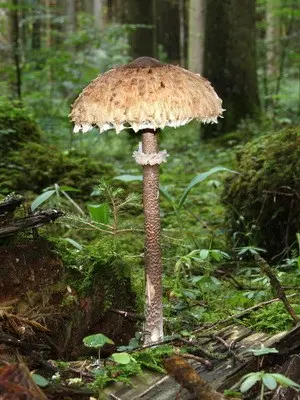
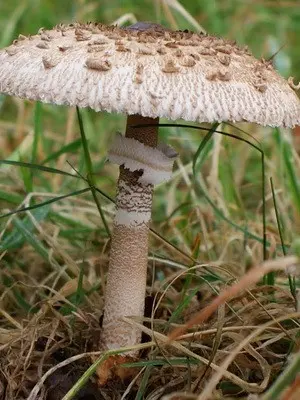
As you can see in the photo of the variegated umbrella mushroom, the edges of its cap are usually bent towards the inside, and in the center there is a dark round tubercle.
Leg (height 10-35 cm): uniform brown. Often with rings of scales, with a ring or the remains of a bedspread on a leg. Hollow and fibrous, cylindrical and easily separated from the cap. At the very base, a rounded thickening is noticeable.
Records: frequent and free, white or light gray. Easily separated from the hat.
Pulp: loose and white. It has a weak but pleasant mushroom aroma, tastes like walnut or champignons.
According to the description, the variegated umbrella mushroom is similar to poisonous chlorophyllums – lead slag (Chlorophyllum molybdites) and Chlorophyllum brunneum. Lead-slag is much smaller than the variegated umbrella mushroom and is found only in North America, and the flesh of Chlorophyllum brunneum changes color when cut or broken. Also, the variegated umbrella mushroom can be confused with the edible elegant umbrella (Macrolepiota gracilenta) and blushing (Chlorophyllum rhacodes). But the graceful one is much smaller, and the blushing one is not only smaller, but also changes the color of the pulp.
When growing: from mid-June to early November in the countries of the Eurasian continent with a temperate climate, as well as in North and South America, Australia, Cuba and Sri Lanka.
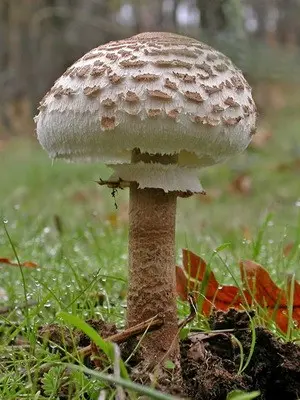

Where can I find: on sandy soils and open spaces, not only in forest meadows or edges, but also in city parks and squares.
Eating: after preliminary cleaning from scales, the hats can be used in cooking in almost any form, including cheese. The legs are hard, so they are not eaten. To taste, a motley umbrella resembles champignons. Especially appreciated by French gourmets, who recommend frying it in oil with herbs. The only drawback is that this mushroom is very fried. In Italy, the motley umbrella is called mazza di tamburo (“drumsticks”).
Use in traditional medicine (data are not confirmed and have not been clinically tested!): in the form of a decoction as a remedy for the treatment of rheumatism.
Other names: large umbrella mushroom, tall umbrella mushroom, “drum sticks”.









